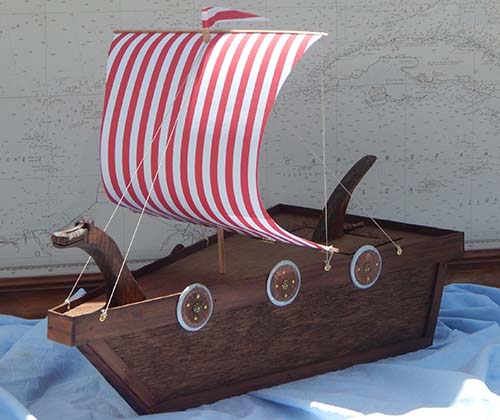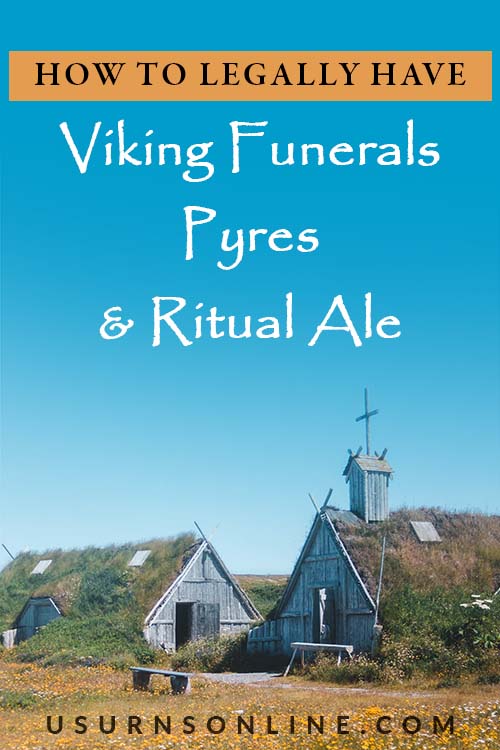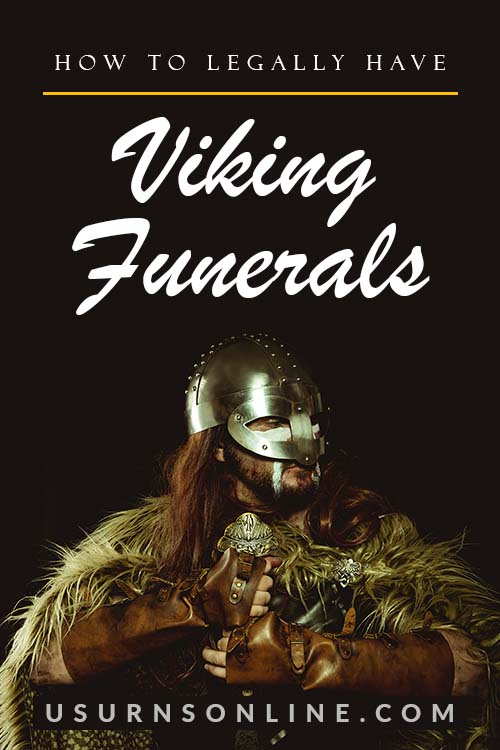The Vikings have not been active for a millennium, but Viking funerals still inspire a sense of awe and wonder. The iconic ritual of a fiery sendoff is something that many people are interested in, and perhaps want to emulate for their own farewell.
But the stuff of legends may be just that. Did the Vikings really send their warriors out to sea on a flaming ship, an aquatic funeral pyre bound for Valhalla?
Here’s everything you need to know about Viking funerals and how you can (sort of… maybe…) legally have your own Viking send-off.
Our website is supported by our users. We sometimes earn a commission when you click through the affiliate links on our website. See our privacy policy & disclosures for more information.
Who Were the Vikings?
The Vikings were Scandinavian sailors, traders, explorers, raiders, pirates and warriors active from the late 8th century well into the 11th century. They made up the bulk of free-roaming mercenaries for the northern seaboard countries of Europe at the time, from Denmark and Sweden all the way to Iceland. They followed the old traditions of pagan cults related to the Norse gods and myths.
Being the marauding culture they were, war was a natural part of their life, and an equally natural way for them to die. In fact, according to Viking lore it was shameful to die any other way. Death was an honored and welcomed part of life, and was celebrated as such in a number of ways.
These were men of the sea, and in death, they accepted the sea to become their tomb.
What Happens at a Viking Funeral?
From what we know today, Viking funerals complete with a flaming sendoff were rare but important occasions. Early Vikings believed that cremation would help send a spirit to the sky, and many sects carried out standard burials in open spaces where many bodies would be collected, not unlike a modern graveyard.
But the true spectacle came with the royalty, the great warriors, the leaders; these were conducted with far more circumstance to give their favored warriors a proper send-off to the afterlife.
Most Viking funerals incorporated some or all of the following:
Urns Made in the USA
- Disposition by flaming ship, funeral pyre, or burial
- Treasures accompany the decedent
- Prayers and rituals to Norse gods, especially relating to entry into Valhalla
- After seven days, the community holds a ritual funeral feast
- Monument erected to pay tribute to the departed warrior’s legacy
Viking Ship Burials
The most famous mode of burial was the ship burial. A special funeral longboat would be constructed for the deceased to rest on. The ship would therefore symbolize a passage into the next life, over the ocean and then into the sky through smoke, as the ship would be set on fire while on the water.
Building a ship was expensive, so this practice, while known, was never widespread enough to occur frequently. This would be done mainly for important figures. The majority of Vikings either accepted burial in a family plot of a mound-yard or cremation via a funeral pyre.
Human Sacrifice
There were many parts to the ceremony of ship burial. The truly elite and powerful would leave behind great wealth, much of which would be incorporated into the Viking’s funeral.
The rich Norsemen would have families and servants to whom they would pass on their earthly goods, but not all wealth would be inherited. Some treasures would accompany them in their burial ship.
Bear in mind, too, that servants were property to these people. Vikings were notorious in keeping and trading slaves across the northern Atlantic. A slave, or even a wife, of a Viking buried by ship would be sent out with them to die in the same fire and sink into the sea so that the king or warrior wouldn’t be alone on their eternal journey.
So, while the flaming Viking burial ship might inspire awe, not everything from their culture is worthy of emulation.
Cremation via Funeral Pyre
Cremation is a very technical process today. We know exactly how to best process a body so that only clean ashes remain.
But in the Viking era, over 1,000 years ago, people knew that fire would burn the bodies away. They also knew that bodies don’t just burn like logs. They need a lot of fire, and it needs to be extremely hot.
When a body needs burning, a pyre – a huge mound of wood – is built to make sure enough fire is present. These fires actually grew hotter than modern crematorium furnaces, and left nothing but bones and metal fragments from tributes.
This was the traditional disposition method for the typical Viking.
Read more: Funeral Pyres & Open Air Cremation – Is It Legal?
Sjaund; or: Viking Funeral Ale
Funerals for the dead are spiritual affairs, but, for the living, funerals are also chances to celebrate the gift of life and the life that has just passed. Throughout human history parties have been held when auspicious funerals happened, including feasts and gatherings of people.
For the Vikings, things were no different. To cap off the funeral and begin the next step of life – the inheritance – people would hold a feast called sjaund (Norse for “seven”) seven days after the death. At the feast everyone would drink a special funeral ale, also called sjaund, in excess.
This party was a way to demarcate the life that has gone, and to settle the records they left behind by, as we say, “Raising a glass” to the departed. Drinking was a social activity, meant to bring people closer together as they said their final farewells.
Norse Funeral Rituals & Beliefs
People often confuse the terms Norse and Scandinavian. Norse refers to a system of beliefs which was prevalent within the area, and not a direct genetic lineage.
People from Scandinavia could be Norse, but the Norse were really the gods they worshiped. These include the gods Odin, Thor, Skadi, Freya, and others.
Norse beliefs are central to Viking culture, including their beliefs of death and the afterworld where the souls of the dead depart to: Valhalla.
Valhalla
Valhalla is the Warrior’s Hall of Odin, a paradise where those who lived and died in battle would go to feast and drink and fight forever until the final day of battle arrived.
This day, Ragnarok, would be the end of the world, when all warriors would be called on to lead a charge against a demonic army and slay monsters that tried to destroy the world of man.
In the end, nothing would be left besides two human survivors, and through them the world would start anew. Valhalla was the end goal for all warriors, their idea of heaven.
Viking Funeral Prayer
As with any religion, prayer was a central part of invoking and worshiping the gods. It was the gods who could potentially be tender to the newly departed souls, and therefore the gods needed to be appeased through prayer, song or tribute.
There were many such prayers, and across such a long span with such a widespread, decentralized culture, there’s no one single prayer that covers the whole gamut of Viking funeral formality. They usually call to the gods, call to the ancestors of the departed, or give praise to the life the warrior lived.
Grave Goods: Weapons, Jewelry, and More
As with many pagan cultures, the belief that the physical could persist into the ethereal was real, and the dead were often buried with their belongings. Especially the rich. They were buried with their wealth, and sometimes with the living at their side. Treasures such as weapons and jewels were common choices.
It was good practice to dress the dead in new clothing so they could face the gods in their best vestments. And no warrior would want to leave for Valhalla without their favored sword which won them their many battles in life.
Related: 50 Beautiful Examples of Cremation Jewelry
Viking Memorial Monuments
The Vikings raised many monuments to celebrate the life of established warriors or lords. Some are monoliths, standing stones carved with runes and details of the person who died, or poems and songs dedicated to them.
One tradition was that of a Stone Ship, an arrangement of stones in the shape of a longboat if the sea was too far, or a real boat was unobtainable.
Hogbacks were also used; stone depictions of longhouses which were used as grave markers to literally “house” the dead, usually for those who would not make it to Valhalla, but would want to be spared from the eternal cold of Hel.
Are Viking Funerals Legal?
A Viking funeral sounds like… well, kind of fun and exciting, all things considered. It’s a flashy, impressive way to send off a loved one, especially if they lived and died for the glory of battle.
Our society has changed greatly from the olden days. It’s become more gentle; some might say softer. There aren’t quite so many warrior cultures in the world that accept someone who wants to fight forever. And, for those that do, it’s more likely they’ll die in the war they want to join. But even if it’s just for the spectacle of the send-off, is a Viking funeral worth having?
Well, you have to omit or adapt a lot. No human sacrificing, for one thing. Valuables are more likely to be split up in ownership than burned or buried with a body.
And then there’s the body itself. Crematoriums are seen as the safest option for cremation. The old ways, funeral pyres or ship burning, are not permitted. You can get away with having a drinking, feasting festival with friends and loved ones. But once you shoot burning arrows at a body, that’s where the law gets involved.
For many reasons – pollution, fire hazard, danger to others, toxic inhalants – having a full-body ship burning is illegal. The ship will sink, and if it sinks at sea or drifts out too far, it could cause a panic with the Coast Guard or local mariners.
Burials at sea aren’t permitted, but what about burials inland? Any fire is cause for alarm with a local department. They have to know what you’re burning and how big the fire will get. Any mention of a “pyre” is a red alarm for them, because of how hot and easily out of control they can get. And as soon as you introduce a human body, that’s a hard line to cross.
DIY Viking Funeral with Cremation

However, you can arrange an alternative way to conduct a Viking funeral. If the body is cremated professionally, the ashes can be sent onto a miniature Viking ship cremation urn. This keeps the fire below any hazard levels, which can then be burned in a controlled manner.
Instead of fire arrows, which are hard to aim and certainly dangerous, use timer-based incendiaries or fireworks. This can add some extra flair to the spectacle from afar. This also permits you to hold the funeral at night. At this time the lights in the sky add to the mythos as guides to raise your eyes to the heavens.
You’re not likely to see a true, honest Viking funeral in this day and age. It was a product of its time. Their culture was one of warriors who sailed the globe searching for a glorious way to die. That allowed them to live glorious lives of accomplishment, both in and out of battle.
If you know someone who lived like a Viking, unafraid of their death, mirthful to the last, we hope you use this information to create your own special way to honor them.
Read Next: Burial at Sea
Pin It





